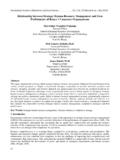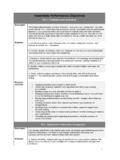Transcription of CAIIB PAPER 1 ADVANCED BANK MANAGEMENT …
1 DEMO FOR PAPER 1 ABM- CAIIB ; Updated Upto CAIIB PAPER 1. ADVANCED BANK MANAGEMENT . INDEX. CHAPTER PAGE NO. MODULE A 2-9. 1. DEMAND & SUPPLY THEORY. 2. Overview of Indian Economy ( Including money, banking , 10-28. inflation, employment, interest & National income & solved numerical of GDP & Union Budget). MODULE B 29-40. 1. TIME VALUE OF MONEY. 2. LINEAR PROGAMMING 41-45. 3. PROBABILITY 46-48. METHODS & NORMAL DISTRIBUTION 49-63. 5. TIME SERIES 63-66. 6. CORRELATION & REGRESSION 67-74. 7. SIMULATION 75-77. 8. BOND VALUATION 78-86. MODULE C 87-126. 1. HR MANAGEMENT . MODULE D 127-139. 1. RATIO ANALYSIS. 2. WORKING CAPITAL 140-160. 3. CREDITS & ITS MANAGEMENT 161-166. 4. LOAN ADMINISTRATION PRE & POST 167-179.
2 MULTIPLE OBJECTIVE QUESTIONS 180-202. MODULE A. CHAPTER 1. DEMAND & SUPPLY THEORY. Introduction Economics may appear to be the study of complicated tables and charts, statistics and numbers, but, more specifically, it is the study of what constitutes rational human behavior in the endeavor to fulfill needs and wants. As an individual, for example, you face the problem of having only limited resources with which to fulfill your wants and needs, so, with your money, you must make certain choices. You'll probably spend part of your money on rent, electricity, and food. Then you might use the rest to go to the movies and/or buy a new pair of jeans. Economists, interested in the choices you make, inquire into why, for instance, you might chose to spend your money on a new DVD player instead of a replacing your old TV.
3 They would want to know whether you would still buy a carton of cigarettes if prices increased by per pack. The underlying essence of economics is trying to understand how both individuals and nations behave in response to certain material constraints.. V. NATIONAL INCOME AND RELATED AGGREGATES. Sectoral Composition of India's National Income According to Colin Clark, the economic development of any country is the transitions from the development of primary sector to the secondary manufactured sector. Such as transformation from primary to secondary sectors involve development of factors of production, skill, technology, resource utilization, human resource development and careful planning. The primary sector is made up of activities like agriculture, forestry, fishing, mining etc.
4 The secondary sector (Industry sector) comprises manufacturing, food processing, transportation equipment, petroleum, textiles, mining, machinery, chemicals, steel, cement and many others. The tertiary sector (Service sector) includes construction, trade, hotels, transport, restaurant, communication and storage, social and personal services, software, community, insurance, financing, business services, and real estate etc. NATIONAL INCOME : It is the money value of all final goods and services produced within the domestic territory of a country in an accounting year plus net factor income from abroad. Gross Domestic Product.:- The total market value of all final goods and services produced in a country in a given year, equal to total consumer, investment and government spending, plus the value of exports, minus the value of imports.
5 1. Gross Domestic Product (GDP): Gross Domestic Product (GDP) is the total market value of all final goods and services currently produced within the domestic territory of a country in a year. Four things must be noted regarding this definition. First, it measures the market value of annual output of goods and services currently produced. This implies that GDP is a monetary measure. Secondly, for calculating GDP accurately, all goods and services produced in any given year must be counted only once so as to avoid double counting. So, GDP should include the value of only final goods and services and ignores the transactions involving intermediate goods. Thirdly, GDP includes only currently produced goods and services in a year.
6 Market transactions involving goods produced in the previous periods such as old houses, old cars, factories built earlier are not included in GDP of the current year. Lastly, GDP refers to the value of goods and services produced within the domestic territory of a country by nationals or non-nationals. 2. Gross National Product (GNP): Gross National Product is the total market value of all final goods and services produced in a year. GNP includes net factor income from abroad whereas GDP does not. Therefore, GNP = GDP + Net factor income from abroad. Net factor income from abroad = factor income received by Indian nationals from abroad factor income paid to foreign nationals working in India. 3. Net National Product (NNP) at Market Price: NNP is the market value of all final goods and services after providing for depreciation.
7 That is, when charges for depreciation are deducted from the GNP we get NNP at market price. Therefore'. NNP = GNP Depreciation Depreciation is the consumption of fixed capital or fall in the value of fixed capital due to wear and tear. National Product (NNP) at Factor Cost (National Income): NNP at factor cost or National Income is the sum of wages, rent, interest and profits paid to factors for their contribution to the production of goods and services in a year. It may be noted that: NNP at Factor Cost = NNP at Market Price Indirect Taxes + Subsidies. Solved Case study: 1. Calculate Gross National Product at market price and Personal Disposable income from the following data: (Rs crores). (i) Subsidy 20 (ii) Net factor income from abroad (-) 60 (iii) Consumption of fixed capital 50 (iv).
8 Personal tax 110 (v) Savings of private corporations 40 (vi) Dividend 20 (vii) Indirect tax 100 (viii). Corporation tax 90 (ix) Net national disposable income 1,000 (x) National debt interest 30 .. UNION BUDGET. Structure of Govt. Budget Budget Receipts Budget Expenditure Revenue Receipts Capital Receipts Tax Non Tax Income Tax Interest Receipt Borrowings Corporate Tax Profits & dividends Recovery of loans Customs Duty Fees and fines Disinvestments Excise Duty Special assessment Small savings & PF. Expenditure Tax External grand in aids Wealth tax Interest Tax Estate duty Budget Expenditure Plan Expenditure None Plan Expenditure Revenue Capital Revenue Capital Central Plans Central Plans & Interst payment Defense capital Assitance to finance- capital Project (on loans taken by Govt) Other defence capital -State & UT plans Loans to state & Payment of salaries Loans to state & UT.
9 Union Territories for Defense service exp. Loans to public their capital projects Subsidies Loans to foreign Govt. Grants to state & UT. Economic services Education & health services Family welfare Food control Rural development Solved Illustration 1: Following figures of X country has been given: 1. Tax Revenue (net to Centre) 186982. 2. Non-tax Revenue 76896. 3. Recoveries of Loans 67265. 4. Other Receipts (capital nature) 16953. 5. Borrowings and Other Liabilities 123272. 6. Plan Expenditure On Revenue Account 78638 .. MODULE B. CHAPTER 1: TIME VALUE OF MONEY. A. Why Mathematics in Banking .. B. Time Value of Money Future value of Annuity: The Future Value of an Annuity is calculated at the end of the period in which the last annuity payment occurs.
10 The Future Value of the Annuity is equal to the sum of the future values of the individual annuity payments at that at time. Thus, the future value of a five year annuity is computed at the end of year five. This can be found in one step through the use of the following equation: It is also be called as FV of Ordinary Annuity where FVA = The Present Value of the Annuity Annui PMT = The Annuity Payment r = The Interest or Discount Rate t = The Number of Years (also the Number of Annuity Payments). Example:-Ordinary Ordinary annuity for for 3 years at 9%. Example:- Compute the future value of ,880 invested every year if the appropriate rate is and you invest the money for 18 years with the first payment made one year from now.









